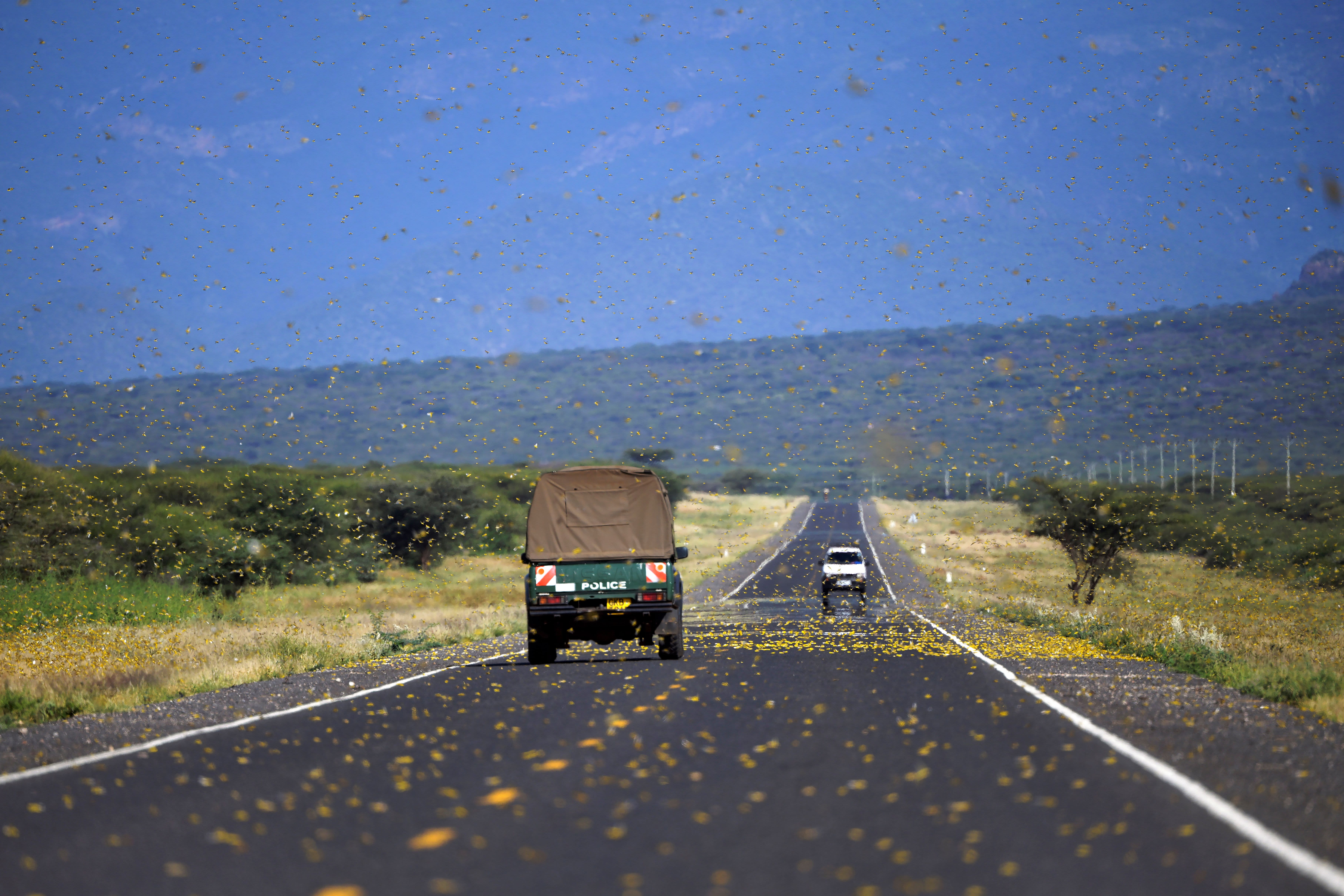
An estimated 20.2 million people are facing severe acute food insecurity across East Africa as swarms of desert locusts ravage crops in an already vulnerable region.
The European Union on Thursday contributed 11 million euros ($12.1 million) to aid the UN Food and Agriculture Organization (FAO) in its efforts to contain the upsurge, which has now expanded from East Africa into the Persian Gulf.
The outbreak is the worst seen in Ethiopia and Somalia for 25 years and the worst infestation in Kenya for over 70 years. Djibouti and Eritrea have also been affected with swarms reported in South Sudan, Uganda and Tanzania.
Strong winds this week have brought swarms to both sides of the Persian Gulf and into Bahrain, Kuwait, Qatar and southwest Iran.
Without concerted efforts to control the outbreak, the UN estimates that conducive breeding conditions could see the locusts multiply by 400 times this year.
Locusts swarm acros a highway at Lerata village, near Archers Post in Samburu county, approximately 300 kilomters (186 miles) north of Kenyan capital, Nairobi on January 22, 2020. (Photo by TONY KARUMBA / AFP) (Photo by TONY KARUMBA/AFP via Getty Images)
Tony Karumba/AFP via Getty Images
The FAO has appealed for $138 million in urgent funding to assist the countries that have been impacted, but has so far amassed only $52 million. FAO Director-General Qu Dongyu has said the locusts threaten to provoke a humanitarian crisis in East Africa and told the international community that “there is no time to waste.”
Desert locusts can travel up to 150 kilometers (95 miles) a day, and a one-square-kilometer swarm can devour as much food as 35,000 people in a single day, according to the UN.
With the main farming season looming in a region which relies on agriculture for roughly one-third of its gross domestic product (GDP) and more than 65% of its employment, time is running out to protect livelihoods.
The region has faced consecutive shocks in recent years, including poor rainfall, flooding, macroeconomic crises and armed conflict, rendering it uniquely vulnerable.
Global response
The Ethiopian government is scrambling to control the locusts going into the Belg, a short rainy season which runs from February to May. The UN funding is intended to strengthen East African governments’ control and surveillance operations by supplying equipment and support to teams on the ground, along with supporting the field evaluation of bio-pesticides.
Alongside the FAO, the Ethiopian Ministry of Agriculture is scaling up aerial and ground operations in the key crop-producing regions of Oromia and SNNP (Southern Nations, Nationalities and Peoples).
“We are at a critical stage at which we need to save the next and subsequent harvests and safeguard the livelihood of the population,” Ethiopia’s FAO Representative Fatouma Seid in a recent statement.
Thus far, the FAO operation in Ethiopia has received $6.5 million from a range of international sources, including the UN Central Emergency Response Fund, the Office of U.S. Foreign Disaster Assistance, Saudi Arabia and Belgium.
Negotiations are ongoing with the U.S. Agency for International Development (AID) and agencies in Sweden and Germany, among others, for an additional $10 million. Of the $138 million total requested by the FAO, $50.5 million has been earmarked for Ethiopia, according to the FAO.
Digital solutions
Along with conventional solutions and reporting requirements placed on affected countries, the FAO has signed a memorandum of understanding (MoU) to fast-track the development of a new mobile app.
The MoU will enable Penn State professor of entomology and biology David Hughes and his team at PlantVillage, an agricultural research and development unit at the university, to create a mobile app which locates and tracks the insects in order to assist in early warning and targeted spraying efforts.
After the last locust upsurge in 2003–2005, the FAO developed a tool to enable national locust officers in frontline countries from West Africa to India to record observations in the field and transmit the data to their National Locust Center in real-time via satellite.
A local resident tries to swot away a swarm of desert locusts in Mathiakani, Kitui County, Kenya, on Saturday, Jan. 25, 2020. The number of locusts in East Africa could expand 500 times by June, the UN’s Food & Agriculture Organization said last month.
Patrick Meinhardt | Bloomberg | Getty Images
A revamped version called eLocust3 was released in 2015. The new iteration, eLocust3M, will provide a more basic but widely accessible version to enable the vastly larger amount of teams currently on the ground and the broader community to use it.
According to Hughes, the locust outbreak is the result of heavy rain and cyclones over the last two years that created ideal breeding conditions.
“This is essentially a citizen science endeavor,” said Hughes. “The more people who are on the ground inputting data into the system, the more accurately we can pinpoint the swarms and the faster we’ll be able to determine where limited resources should be deployed.”
Source: Business - cnbc.com


